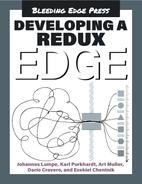0%
14Chapters
0-1Hours read
0kTotal Words
Table of Contents
- Preface
- 1. Why Use Redux?
- 2. Core Concepts
- 3. Redux Patterns
- 4. Building the Sample App
- 5. Syncing Data with the Server
- 6. Showing Request State to Users
- 7. Persisting State on Client
- 8. Analytics Middleware
- 9. Best Practices
- 10. Going offline
